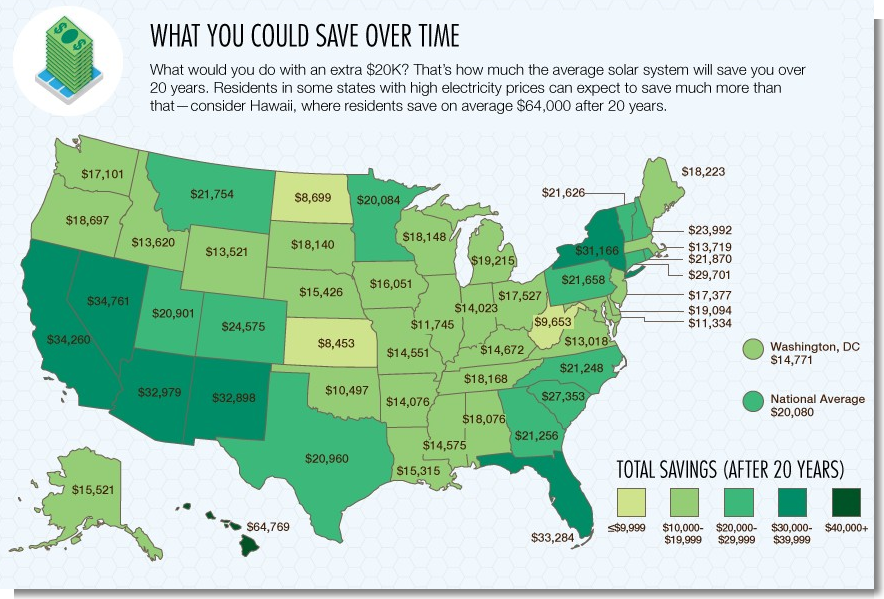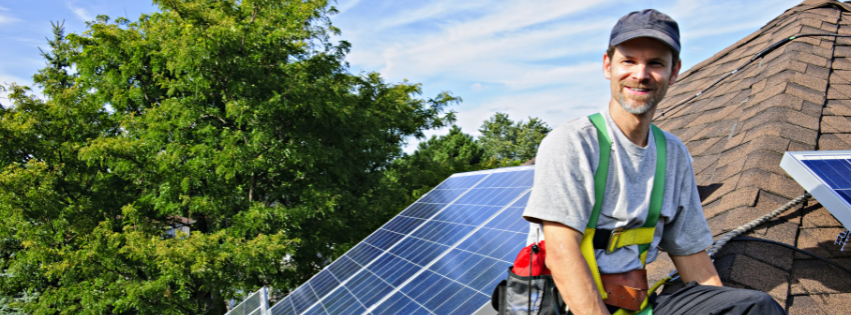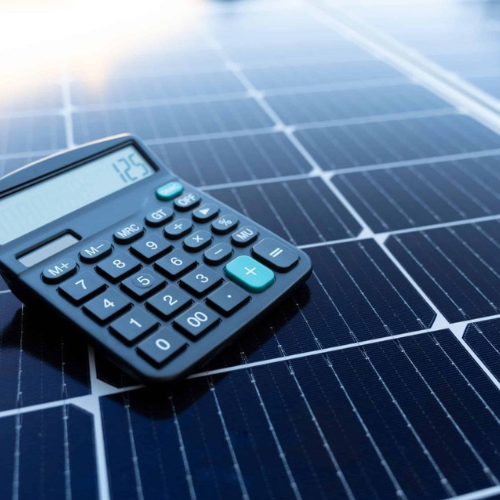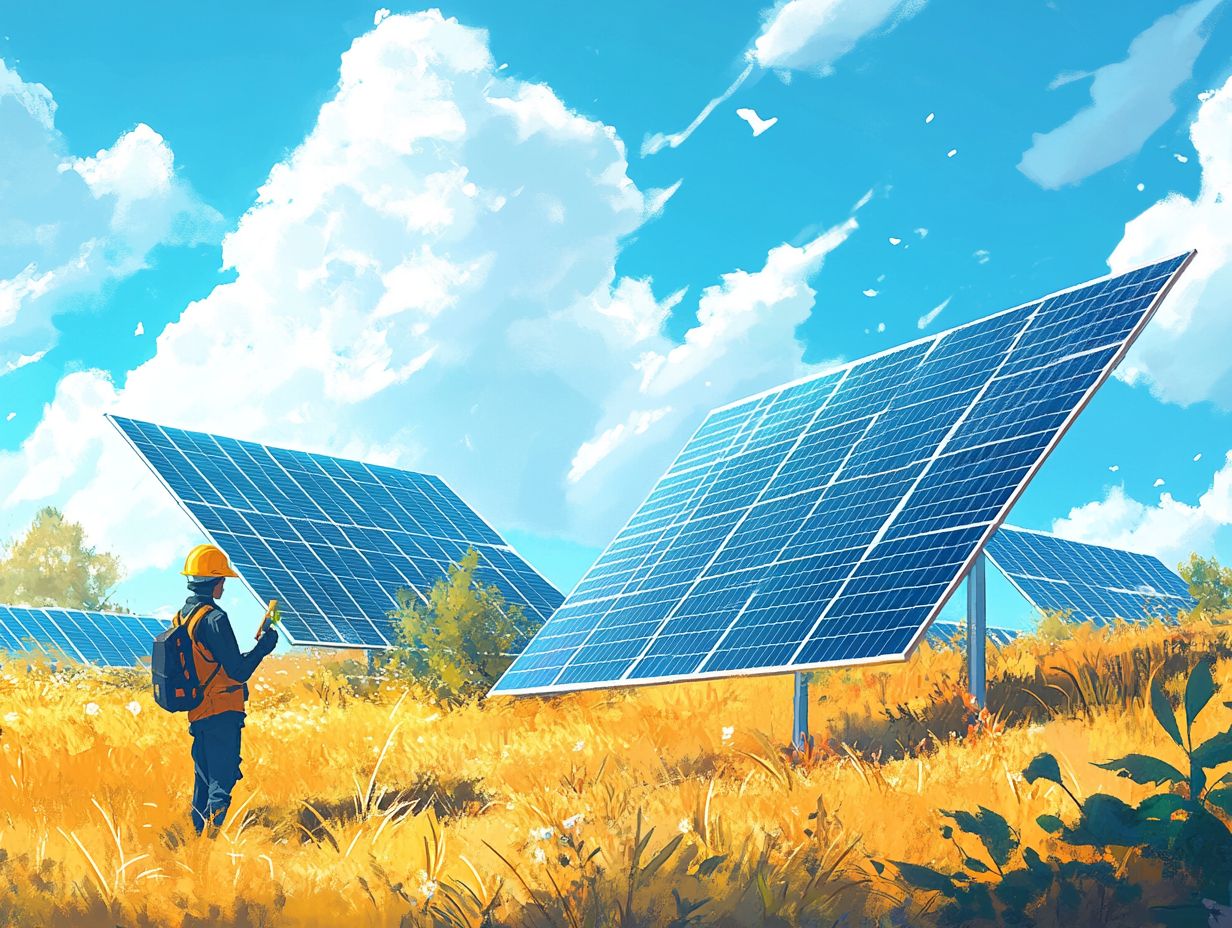Contents
- 1 1. Slash Your Energy Bills
- 2 2. Shrink Your Carbon Footprint
- 3 3. Embrace Energy Independence
- 4 4. Ride the Wave of Innovation
- 5 Implementing Your Solar Solution
- 6 Avoiding Common issues
- 7 Adapting Solar to Different Scenarios
- 8 From Basics to Mastery
- 9 Practice Makes Perfect
- 10 Key Takeaways
- 11 People Also Asked
- 11.1 How much does it cost to install solar panels?
- 11.2 How long does it take for solar panels to pay for themselves?
- 11.3 Do solar panels work on cloudy days?
- 11.4 How long do solar panels last?
- 11.5 Can I install solar panels myself?
- 11.6 What maintenance do solar panels need?
- 11.7 Can I store solar energy for use at night?
- 11.8 Do solar panels increase home value?
- 11.9 What happens to solar panels during a power outage?
- 11.10 Are there any tax credits available for installing solar panels?
- 11.11 How do I know if my home is suitable for solar panels?
- 11.12 What happens to solar panels at the end of their life?
- 11.13 Can I sell excess electricity back to the grid?
- 11.14 How do solar panels impact my roof?
- 11.15 What’s the difference between monocrystalline and polycrystalline solar panels?
- 11.16 How do solar panels work in winter?
- 11.17 Can solar panels be installed on a flat roof?
- 11.18 How many solar panels do I need to power my home?
- 11.19 Are there choices to rooftop solar panels?
- 11.20 How do solar panels affect my home insurance?
- 11.21 Key Takeaways
As someone who’s been in the solar industry for years, I’ve seen firsthand how this technology has revolutionized homes and businesses. Installing solar energy isn’t just a trend – it’s a powerful solution to many of our energy and environmental challenges.
Let’s explore the four most compelling reasons why installing solar energy could be the smartest decision you’ll make this year.
1. Slash Your Energy Bills
Opening your electricity bill can be a source of dread for many homeowners. But solar energy changes that equation dramatically.
When you install solar panels, you’re essentially creating your own power plant right on your roof.
During daylight hours, your panels work tirelessly, converting sunlight into electricity to power your home.
The savings from solar can be substantial. Many homeowners see their electricity bills drop by 50% to 90%.
Over the 25 to 30-year lifespan of a typical solar system, these savings really add up.
A study by the National Renewable Energy Laboratory found that homeowners in sunny states like California saved an average of $19,000 over 20 years by going solar.
What’s even more exciting is that as utility rates continue to rise (and they always do), your savings grow even more. It’s like giving yourself a raise every year without having to ask your boss.
The financial benefits of solar extend beyond just reducing your monthly bills.
Many areas offer net metering programs, where excess energy you produce is fed back into the grid, potentially earning you credits.
Solar energy also increases your home’s value. A study by Zillow found that homes with solar panels sell for 4.1% more on average than comparable homes without solar.
Many governments offer incentives for solar installation.
The federal solar investment tax credit (ITC) allows you to remove 30% of the cost of installing a solar energy system from your federal taxes. Many states and local governments offer extra tax credits, rebates, and other incentives that can further reduce the cost of going solar.
2. Shrink Your Carbon Footprint
Climate change is one of the most pressing issues of our time, and solar energy offers a powerful way to combat it. Unlike traditional power sources that burn fossil fuels and release harmful greenhouse gases, solar panels produce absolutely zero emissions during operation.
A typical residential solar system can offset about 3-4 tons of carbon emissions annually. To put that into perspective, it’s equivalent to planting over 100 trees every single year!
Over the lifetime of your solar panels, you could prevent tens of thousands of pounds of carbon dioxide from entering the atmosphere.
The environmental benefits of solar extend beyond just reducing carbon emissions. Solar energy helps conserve water resources.
Traditional power plants use large amounts of water for cooling, while solar panels need no water to generate electricity.
In drought-prone areas, this water conservation aspect of solar energy is particularly crucial.
Solar energy also reduces air pollution. Fossil fuel power plants release particulate matter, nitrogen oxides, and sulfur dioxide into the air, contributing to respiratory diseases and other health problems.
By switching to solar, you’re not just helping the planet – you’re contributing to cleaner air and better health for your community.
The International Renewable Energy Agency projects that by 2050, solar PV could help reduce CO2 emissions by 4.9 gigatons annually. That’s like taking over a billion cars off the road each year!
By installing solar panels, you’re playing a direct role in this global effort to combat climate change.
Some people worry about the environmental impact of manufacturing solar panels. While it’s true that producing solar panels does have some environmental cost, most panels offset their production emissions within 1-4 years of use.
Considering they last for decades, that’s a pretty impressive return on environmental investment.
3. Embrace Energy Independence
There’s something incredibly empowering about generating your own electricity. When you install solar panels, you’re reducing your reliance on the traditional power grid.
This means you’re less vulnerable to power outages, rising energy costs, and the whims of utility companies.
Energy independence is not about individual homes. On a larger scale, widespread adoption of solar energy can enhance national security by reducing our dependence on foreign energy sources.
It creates a more distributed, resilient energy infrastructure that’s less vulnerable to large-scale disruptions or attacks.
Solar energy, especially when paired with battery storage, can provide power even during grid outages. This resilience is becoming increasingly important as extreme weather events become more common because of climate change.
In some cases, solar with battery storage can even allow for finish off-grid living.
The concept of energy independence extends to economic independence as well. The solar industry is a major job creator.
According to the U.S. Department of Energy, the solar workforce has grown by 167% over the past decade, adding 156,000 jobs.
By going solar, you’re not just investing in your own energy independence – you’re supporting a growing industry that’s creating jobs and driving economic growth.
Energy independence also means price stability. While utility rates fluctuate and generally trend upward, the cost of your solar energy stays constant once you’ve installed your system.
This predictability can be a significant advantage for both homeowners and businesses in managing their energy costs.
4. Ride the Wave of Innovation
Solar technology is advancing at a breakneck pace, and by installing solar now, you’re positioning yourself to take advantage of future innovations. Solar cell efficiency is constantly improving.
The current record for multi-junction cells stands at an impressive 47.1% efficiency.
That means nearly half of the sunlight hitting these advanced cells is converted into usable electricity.
While commercial panels aren’t quite at that level yet, they’re getting better all the time. The average efficiency of commercial solar panels has doubled in the last 20 years, and this trend is expected to continue.
By installing solar now, you’re creating a foundation that can be upgraded and improved as technology advances.
We’re also seeing exciting developments in solar integration. Researchers are working on transparent solar cells that could be used in windows, potentially turning entire buildings into power generators.
There’s even research into solar fabrics that could turn your clothes into mobile power sources.
Space-based solar power is another frontier of solar innovation. This technology could provide continuous, high-yield energy unaffected by weather or day/night cycles.
While this might seem like science fiction, several countries and private companies are actively pursuing this technology.
Energy storage is another area of rapid innovation that complements solar energy. As battery technology improves, solar energy systems will become even more effective, allowing you to store excess energy for use at night or during cloudy days.
The cost of lithium-ion batteries has fallen by 97% since 1991, making energy storage increasingly accessible.
Smart home technology is also evolving to work seamlessly with solar systems. Advanced energy management systems can improve your energy use, automatically adjusting your consumption based on your solar production and energy prices.
This integration of solar with smart home technology can maximize your energy savings and efficiency.
By installing solar now, you’re not just benefiting from current technology – you’re creating a platform that can be upgraded and enhanced as new innovations emerge. You’re future-proofing your home’s energy system and positioning yourself at the forefront of the clean energy revolution.
Implementing Your Solar Solution
Now that we’ve explored the compelling reasons to go solar, let’s talk about how to make it a reality for your home or business.
Assessment
The first step is a professional solar assessment. A solar expert will assess your roof’s orientation, shading, and structural integrity to determine if solar is right for you.
They’ll also analyze your energy usage patterns to design a system that meets your specific needs.
During the assessment, the solar professional will use sophisticated tools to measure your roof’s solar potential. They’ll consider factors like the angle of your roof, its orientation to the sun, and any potential shading from trees or nearby buildings.
They’ll also check your roof’s condition to ensure it can support the weight of solar panels.
The assessment will also include a review of your past electricity bills. This helps determine the size of the solar system you’ll need to offset your energy usage.
The goal is to design a system that maximizes your energy savings without oversizing, which could lead to unnecessary costs.
System Design
Based on your energy needs and roof characteristics, a custom system will be designed for most efficiency. This design process involves selecting the right type and number of solar panels, determining their optimal placement, and choosing the suitable inverter technology.
The system designer will use specialized software to create a 3D model of your roof and simulate the solar system’s performance throughout the year. This allows them to improve the panel layout for most energy production.
The design process also involves selecting the right components. There are many types of solar panels available, each with different efficiency ratings and aesthetic qualities.
The designer will help you choose the panels that best fit your needs and budget.
Inverters, which convert the DC electricity produced by solar panels into AC electricity used in your home, are another crucial component. The designer will determine whether a string inverter, microinverters, or power optimizers are best for your situation.
Permitting
Your installer will handle the necessary allows and paperwork. This can take a few weeks, so be patient!
The permitting process varies by location but typically involves submitting system designs and electrical diagrams to your local building department for approval.
In some areas, you may also need approval from your homeowners’ association. Your installer should be familiar with local regulations and can guide you through this process.
The permitting phase also involves applying for any available incentives or rebates. Your installer should help you navigate these programs to maximize your savings.
Installation
The actual installation usually only takes a day or two. It’s exciting to watch your roof transform into a power plant!
The installation team will start by preparing your roof, which may involve reinforcing the structure if necessary.
Next, they’ll install the racking system that will hold your solar panels. The panels are then carefully placed and secured to the racking.
After the panels are in place, the team will wire them together and connect them to the inverter.
The final step of installation is connecting your solar system to your home’s electrical system and installing a new electrical meter if required for net metering.
Inspection and Activation
After installation, your system will be inspected and, once approved, connected to the grid. This typically involves an inspection by your local building department to ensure the system meets all safety codes.
Once your system passes inspection, your utility company will give final approval and install a new meter if necessary. At this point, you can officially activate your solar system and start generating your own clean energy!
Avoiding Common issues
While going solar is generally straightforward, there are a few potential pitfalls, problems, issues, problems, issues, problems, issues to watch out for:
Oversizing
Some installers might try to sell you a larger system than you need. Stick to a size that matches your actual energy usage. An oversized system can lead to unnecessary costs and may not provide extra benefits if your utility doesn’t offer favorable net metering rates.
To avoid this, carefully review your past electricity bills and future energy needs with your installer. If you’re planning significant changes that could affect your energy usage (like buying an electric vehicle or making your home more energy-efficient), factor these into your calculations.
Ignoring Efficiency
Before going solar, make sure your home is as energy-efficient as possible. This could reduce the size (and cost) of the system you need. Simple steps like upgrading to LED lighting, improving insulation, and using energy-efficient appliances can significantly reduce your energy consumption.
Consider getting an energy audit before installing solar. This can identify areas where you can improve your home’s energy efficiency, potentially reducing the size of the solar system you need.
Neglecting Maintenance
While solar panels are low-maintenance, they’re not no-maintenance. Regular cleaning and check-ups will keep them operating at peak efficiency.
In most areas, rain will do most of the cleaning for you, but you may need to occasionally remove debris or snow.
It’s also important to watch your system’s performance. Many modern solar systems come with monitoring apps that allow you to track your energy production in real-time.
If you notice a significant drop in production, it could show a problem that needs attention.
Forgetting About Warranties
Make sure you understand what’s covered by your warranties and for how long. Typically, solar panels come with two warranties: a product warranty that covers defects (usually 10-12 years) and a performance warranty that guarantees a certain level of power output (often 25 years).
Inverters usually have shorter warranties, typically 5-10 years. Some installers also offer workmanship warranties covering their installation work.
Keep all warranty documentation in a safe place and be aware of any maintenance requirements to keep your warranties valid.
Adapting Solar to Different Scenarios
Solar isn’t one-size-fits-all. Here are some tips for adapting solar to different situations:
Renters
If you’re renting, you might think solar is out of reach. But there are options!
Look into community solar projects, which allow you to subscribe to a share of a larger solar installation.
Some areas also allow “solar gardens” where you can own panels in a centralized location.
Portable solar devices are another option for renters. These can range from small solar chargers for your devices to larger portable panels that can power small appliances.
Shaded Roofs
If your roof is heavily shaded, traditional rooftop solar might not be the best option. But don’t give up!
Consider ground-mounted systems if you have available land.
These can be placed in the sunniest spot on your property and are often easier to maintain.
Solar canopies are another option. These structures can be built over parking areas or patios, providing both shade and energy generation.
Historic Homes
Owners of historic homes often worry that solar panels will detract from their home’s character. Fortunately, there are less visible options.
Solar shingles or tiles integrate seamlessly with your roof, preserving your home’s aesthetic while still generating clean energy.
Some historic districts have specific guidelines for solar installations. Work closely with your local historic preservation office to find a solution that respects your home’s heritage while allowing you to benefit from solar energy.
Businesses
Businesses often have larger roof spaces, allowing for bigger systems and greater savings. Commercial solar installations can significantly reduce operating costs and show a commitment to sustainability, which can be a powerful marketing tool.
Many businesses are also exploring power purchase agreements (PPAs) where a third party owns and maintains the solar system, and the business agrees to purchase the power generated at a set rate. This can allow businesses to go solar with little to no upfront cost.
From Basics to Mastery
Installing solar energy is just the beginning. As you become more familiar with your system, you might find yourself diving deeper into energy management.
You could explore adding battery storage, integrating your solar system with smart home technology, or even getting involved in local energy policy.
Battery storage systems, like the Tesla Powerwall or LG Chem RESU, allow you to store excess energy generated during the day for use at night or during power outages. This can increase your energy independence and potentially save you more money, especially if your utility uses time-of-use rates.
Smart home integration can take your solar system to the next level. Smart thermostats, for example, can be programmed to run energy-intensive tasks when your solar production is at its peak.
Smart appliances can be set to operate during times of high solar production, maximizing your use of self-generated power.
Some solar enthusiasts even get involved in local energy policy. You could advocate for better net metering policies, push for community solar projects, or support initiatives to increase renewable energy adoption in your area.
Practice Makes Perfect
To really understand the impact of solar, try these exercises:
Track your energy usage for a month, then calculate how much you could save with solar. Most utility companies provide detailed usage data that you can analyze.
Look for patterns in your energy consumption and think about how they align with typical solar production hours.
Research solar incentives available in your area. Start with the Database of State Incentives for Renewables & Efficiency (DSIRE), which provides comprehensive information on incentives and policies that support renewable energy in the United States.
Use an online solar calculator to estimate the size and cost of a system for your home. Many solar companies offer these tools on their websites.
These are estimates and a professional assessment will provide more accurate figures.
Visit a home with solar panels and talk to the owner about their experience. Many solar owners are enthusiastic about sharing their experiences.
You might even find solar home tours organized in your area.
Key Takeaways
- Solar can significantly reduce your energy bills, potentially saving you thousands over the system’s lifetime.
- It’s a powerful way to reduce your carbon footprint, with each installation offsetting tons of CO2 emissions annually.
- Solar provides energy independence and security, reducing reliance on the grid and fossil fuels.
- The technology is constantly improving, offering future benefits as you upgrade and enhance your system.
People Also Asked
How much does it cost to install solar panels?
The cost of installing solar panels varies widely depending on factors like system size, location, and available incentives. As of 2023, the average cost for a residential solar system in the U.S. ranges from $15,000 to $25,000 before incentives.
How long does it take for solar panels to pay for themselves?
The payback period for solar panels typically ranges from 5 to 10 years, depending on factors like electricity rates, solar production, and available incentives. In areas with high electricity costs and strong solar incentives, the payback period can be even shorter.
Do solar panels work on cloudy days?
Yes, solar panels do work on cloudy days, although their efficiency is reduced. Modern solar panels can still produce 10-25% of their normal power output on cloudy days.
How long do solar panels last?
Most solar panels come with a 25-30 year warranty and are expected to last even longer. Their efficiency may decrease slightly over time, but many panels still produce at 80% or more of their original capacity after 25 years.
Can I install solar panels myself?
While it’s technically possible to install solar panels yourself, it’s not recommended. Professional installation confirms safety, proper system design, and compliance with local codes and regulations. DIY installation may also void warranties and make you ineligible for certain incentives.
What maintenance do solar panels need?
Solar panels need minimal maintenance. Regular cleaning (which can often be done by rain in many climates) and occasional inspections are typically all that’s needed. It’s recommended to have a professional inspection every few years to ensure optimal performance.
Can I store solar energy for use at night?
Yes, you can store solar energy for use at night with a battery storage system. These systems, like the Tesla Powerwall, allow you to store excess energy produced during the day for use when your panels aren’t producing electricity.
Do solar panels increase home value?
Yes, studies have shown that homes with solar panels typically sell for more than comparable homes without solar. A study by Zillow found that homes with solar panels sell for 4.1% more on average.
What happens to solar panels during a power outage?
Standard grid-tied solar systems will shut off during a power outage for safety reasons. However, systems with battery backup or special inverters can continue to provide power during outages.
Are there any tax credits available for installing solar panels?
Yes, the federal government offers a solar investment tax credit (ITC) that allows you to remove 30% of the cost of installing a solar energy system from your federal taxes. Many states and local governments offer extra incentives as well.
How do I know if my home is suitable for solar panels?
Factors that determine suitability include roof orientation, shading, roof condition, and local climate. A professional solar assessment can determine if your home is a good candidate for solar.
What happens to solar panels at the end of their life?
Most solar panels can be recycled at the end of their life. The industry is developing more effective recycling processes to recover and reuse materials from old solar panels.
Can I sell excess electricity back to the grid?
Many utilities offer net metering programs that allow you to sell excess electricity back to the grid, often in the form of credits on your electricity bill. Policies vary by location, so check with your local utility.
How do solar panels impact my roof?
When properly installed, solar panels can actually protect your roof by shielding it from the elements. However, it’s important that your roof is in good condition before installation.
Most solar installers offer warranties that cover any roof damage that might occur during installation.
What’s the difference between monocrystalline and polycrystalline solar panels?
Monocrystalline panels are made from a single crystal structure and are generally more effective and aesthetically pleasing, and more expensive. Polycrystalline panels are made from multiple crystal structures, are slightly less effective, but are typically more affordable.
How do solar panels work in winter?
Solar panels can actually work more efficiently in colder temperatures. However, shorter days and potential snow cover can reduce overall production.
Many systems are designed to account for seasonal variations in production.
Can solar panels be installed on a flat roof?
Yes, solar panels can be installed on flat roofs using special mounting systems that tilt the panels at the optimal angle for solar production.
How many solar panels do I need to power my home?
The number of panels needed depends on your energy usage, panel efficiency, and available roof space. A typical home might need 20-25 panels, but this can vary widely.
A professional assessment can provide an accurate estimate for your specific situation.
Are there choices to rooftop solar panels?
Yes, choices include ground-mounted systems, solar shingles, solar canopies, and community solar projects. These options can be suitable for homes where traditional rooftop installation isn’t ideal.
How do solar panels affect my home insurance?
Most home insurance policies cover solar panels as part of the home’s structure. However, you should tell your insurance company when you install solar panels, as you may need to increase your coverage to account for the added value to your home.
Key Takeaways
- Solar energy offers significant financial savings through reduced electricity bills and potential tax incentives.
- Installing solar panels dramatically reduces your carbon footprint, contributing to global efforts against climate change.
- Solar provides energy independence, protecting you from rising utility costs and power outages.
- The solar industry is rapidly advancing, with innovations in efficiency, storage, and integration constantly emerging.
- While there are some challenges to consider, proper planning and professional installation can help you maximize the benefits of solar energy.









